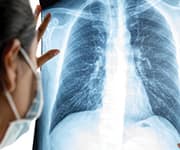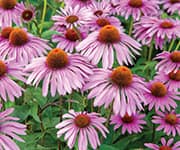LIFE EXTENSION MAGAZINE
Echinacea is an immune enhancing plant.
Clinical studies have shown that compared to placebo, echinacea use can lead to an improvement in cold symptoms, fewer days with severe symptoms, and reduction in cold incidence and severity. 1-3
But not all echinacea is the same.
Different active components are found in different species of echinacea and in different parts of the plant.
Many echinacea supplements contain only one species, with 80% of products relying solely on Echinacea purpurea.
Not all contain standardized ingredients. This results in inconsistent potency.4
To maximize echinacea’s full immune supportive potential, look for supplements containing extracts from various parts of the plant, as well as more than one plant species.
This can deliver echinacea’s spectrum of immune-boosting benefits.
What is Echinacea?
Echinacea is a plant native to central and eastern North America. It was used as folk medicine by Native Americans to reduce cold symptoms and treat coughs, sore throat, and headaches.
When explorers Lewis and Clark learned about the uses of this medicinal plant in 1805, they considered it one of their most important finds, mailing its seeds and roots back to President Thomas Jefferson.5
Today, echinacea extracts are used to boost immune function and treat flu, colds, and other upper respiratory tract infections. It is also an anti-inflammatory.
Echinacea’s effects derive from its bioactive compounds, including phenolics, polysaccharides, alkamides, caffeic acid derivatives, and others.
These active components are found in different parts of the plant (the roots, flowers, leaves, and others) and in different echinacea species. Research suggests that the clinical effects are likely due to these multiple bioactive compounds which may have a synergistic effect.6,7
How Echinacea Works
The compounds in echinacea work in different ways to enhance immune function and deliver other benefits. For example:7
- Phenolic compounds provide antiviral, antitumor, and antioxidant activity.
- Polysaccharides provide immunomodulating and anti-inflammatory effects. They stimulate macrophages (immune cells that destroy harmful microorganisms), which in turn secrete signaling proteins that enhance virus-killing natural killer (NK) cells.
- Alkamides provide immunomodulating, anti-inflammatory, and antifungal effects, and protect NK cells against compounds that can inhibit their activity.
Boosting Immunity
Preclinical studies support echinacea’s use for immune support:
- One study found that echinacea produced a two-fold increase in natural killer cell activity in a type of human immune cell known as peripheral blood mononuclear cells (PBMCs).8
- In another study on human PBMCs, compared to baseline, echinacea resulted in a reduction in pro-inflammatory compounds of up to 24% and a 13% increase in interleukin 10 (IL-10), an anti-inflammatory factor.9
- A study on aging mice showed that echinacea increased NK cell numbers by 30% and activity by 20%.10
- Studies on mice found that echinacea boosted NK cell activity11 and that lifelong echinacea use significantly increased lifespan.12
- A systemic review of preclinical and clinical studies found that echinacea may decrease pro-inflammatory cytokines and increase levels of anti-inflammatory cytokines.13
This immune support explains how echinacea may defend against illnesses like the common cold and flu.
Fighting Upper Respiratory Tract Infections
To evaluate the ability of echinacea to help prevent upper respiratory tract infections, researchers conducted a meta-analysis of 24 controlled trials, involving a total of 4,631 participants.6
These clinical trials had used various echinacea preparations from different species, with dosages ranging anywhere from 40 mg to 4,000 mg per day.
The meta-analysis found that echinacea use was associated with an absolute reduction of 10% in the risk of contracting a cold, compared to placebo.6
When the clinical trials included in the study are examined individually, the effects of echinacea on the common cold are more dramatic.
These individual studies document an array of improvements with echinacea use compared to placebo, including:6
- 58.7% improvement in symptoms compared to 33.6% with placebo,1
- 33.3% fewer days with severe symptoms,2
- 36% relative reduction in cold incidence and severity following travel,3 and
- 3.4 days duration of upper respiratory tract infection, versus 8.6 days with placebo.14
These human studies used different echinacea species and different echinacea plant parts, and each trial demonstrated a different type or level of protection against upper respiratory tract infections.
This suggests that using more than one echinacea species and multiple parts of the plant is the best way to maximize echinacea defense.
What you need to know
Getting the Most from Echinacea
- The immune supportive effects of echinacea help it defend against upper respiratory tract infections. Clinical studies have shown that compared to placebo, echinacea use can lead to an improvement in cold symptoms, fewer days with severe symptoms, and reduction in cold incidence and severity.
- Different active components are found in different species of echinacea and in different parts of the plant. Many echinacea products contain only one species and one plant part.
- Studies suggest that to receive echinacea’s complete spectrum of immune-boosting and antiviral benefits, it is critical to select a product that contains extracts from various parts of the plant, as well as more than one plant species.
Summary
Echinacea delivers immune support and varying degrees of protection against colds, flu, and other upper respiratory tract infections.
Different bioactive compounds behind this immune support are found in different echinacea species and different parts of the plant.
Many echinacea supplements contain only one species and provide only one part of the plant. This diminishes the wide range of biologically active components and their immune-supporting effects.
The best way to obtain echinacea’s full immune support and anti-viral power is by taking extracts from various parts of the plant, as well as more than one plant species.
If you have any questions on the scientific content of this article, please call a Life Extension Wellness Specialist at 1-866-864-3027.
References
- Brinkeborn RM, Shah DV, Degenring FH. Echinaforce and other Echinacea fresh plant preparations in the treatment of the common cold. A randomized, placebo controlled, double-blind clinical trial. Phytomedicine. 1999 Mar;6(1):1-6.
- Schulten B, Bulitta M, Ballering-Bruhl B, et al. Efficacy of Echinacea purpurea in patients with a common cold. A placebo-controlled, randomised, double-blind clinical trial. Arzneimittelforschung. 2001;51(7):563-8.
- Tiralongo E, Lea RA, Wee SS, et al. Randomised, double blind, placebo-controlled trial of echinacea supplementation in air travellers. Evid Based Complement Alternat Med. 2012;2012:417267.
- Available at: https://www.consumerlab.com/reviews/echinacea-review/echinacea/. Accessed August 12, 2022.
- Kindscher K. The Uses of Echinacea angustifolia and Other Echinacea Species by Native Americans. In: Kindscher K, ed. Echinacea. Cham: Springer International Publishing; 2016:9-20.
- Karsch-Volk M, Barrett B, Kiefer D, et al. Echinacea for preventing and treating the common cold. Cochrane Database Syst Rev. 2014 Feb 20;2(2):CD000530.
- Dalby-Brown L, Barsett H, Landbo AK, et al. Synergistic antioxidative effects of alkamides, caffeic acid derivatives, and polysaccharide fractions from Echinacea purpurea on in vitro oxidation of human low-density lipoproteins. J Agric Food Chem. 2005 Nov 30;53(24):9413-23.
- Gan XH, Zhang L, Heber D, et al. Mechanism of activation of human peripheral blood NK cells at the single cell level by Echinacea water soluble extracts: recruitment of lymphocyte-target conjugates and killer cells and activation of programming for lysis. Int Immunopharmacol. 2003 Jun;3(6):811-24.
- Ritchie MR, Gertsch J, Klein P, et al. Effects of Echinaforce(R) treatment on ex vivo-stimulated blood cells. Phytomedicine. 2011 Jul 15;18(10):826-31.
- Currier NL, Miller SC. Natural killer cells from aging mice treated with extracts from Echinacea purpurea are quantitatively and functionally rejuvenated. Exp Gerontol. 2000 Aug;35(5):627-39.
- Park SJ, Lee M, Kim D, et al. Echinacea purpurea Extract Enhances Natural Killer Cell Activity In Vivo by Upregulating MHC II and Th1-type CD4(+) T Cell Responses. J Med Food. 2021 Oct;24(10):1039-49.
- Brousseau M, Miller SC. Enhancement of natural killer cells and increased survival of aging mice fed daily Echinacea root extract from youth. Biogerontology. 2005 2005/05/01;6(3):157-63.
- Aucoin M, Cardozo V, McLaren MD, et al. A systematic review on the effects of Echinacea supplementation on cytokine levels: Is there a role in COVID-19? Metabol Open. 2021 Sep;11:100115.
- Hall H, Fahlman MM, Engels HJ. Echinacea purpurea and mucosal immunity. Int J Sports Med. 2007 Sep;28(9):792-7.





